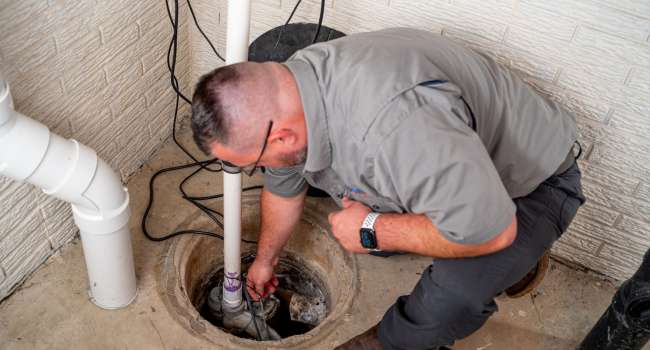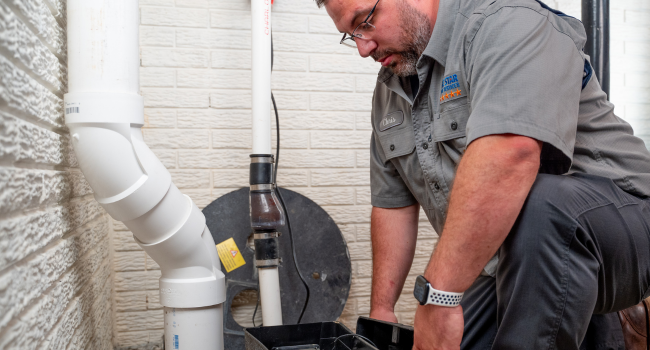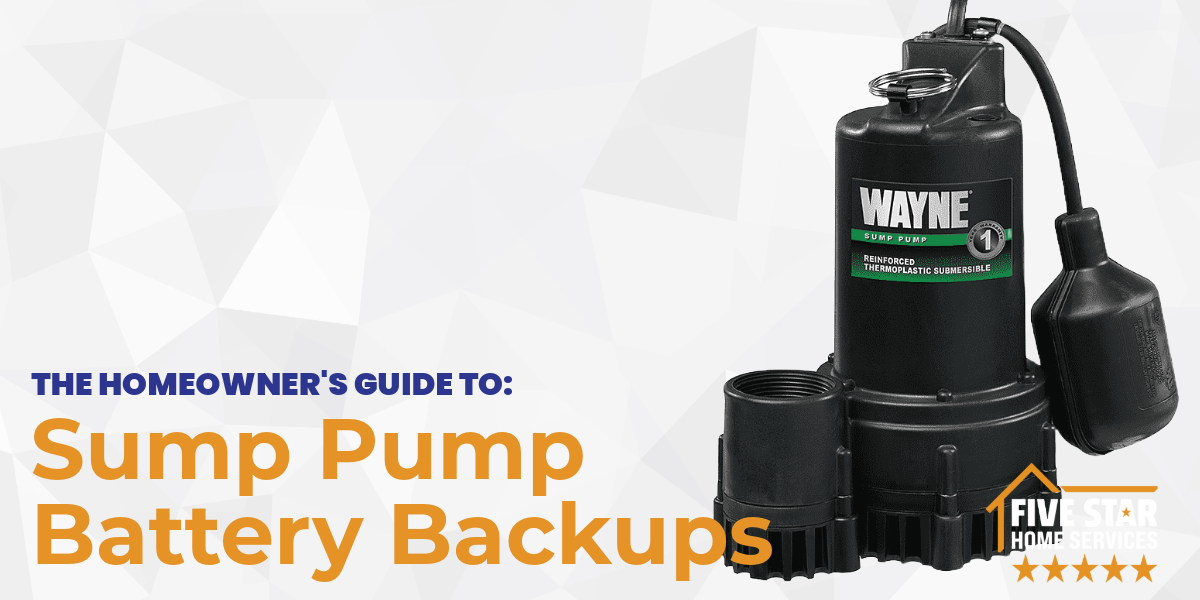Is your basement protected during a power outage?
During a storm or unexpected power outage, your primary sump pump might fail, leaving your basement vulnerable to flooding and costly water damage. That’s where a sump pump battery backup comes in—it keeps your basement dry and your stress levels low.
What Is a Sump Pump Battery Backup?
It’s exactly what it sounds like—a backup power source for your sump pump. If your primary pump loses power, the backup kicks in automatically to keep your basement or crawl space safe from flooding.
A sump pump battery backup is exactly what it sounds like—a secondary power source for your sump pump. It’s meant to kick in automatically if your primary pump stops working, keeping your basement or crawl space safe from flooding during a power outage.

How Does It Work?
- Automatic Activation: When your primary sump pump loses power or fails, the backup pump automatically springs into action.
- Battery Power: It runs on a rechargeable battery, ensuring your sump pump can operate continuously, even during extended outages.
- Water Management: The backup pump seamlessly continues to discharge water from your sump pit to prevent basement flooding.
Key Features to Look For
Thinking about getting a sump pump battery backup? Here’s what to look for:
- Automatic Charging: It keeps the battery ready whenever you need it.
- Compatibility: Make sure it works with your sump pump system.
- Alerts and Alarms: So you’ll know right away when the backup kicks in.
Why Should You Invest in a Sump Pump Battery Backup?
Let’s face it—storms and power outages are unpredictable. Without a backup system, even a short outage or a single inch of water can lead to devastating flooding and expensive repairs. A sump pump battery backup gives you:
- Peace of Mind: You know your basement is protected, even when the power’s out.
- Power Outages: Sump pumps need electricity to work, but storms often cause power outages when they’re needed most. Without power, your sump pump stops, leaving your home at risk of flooding. A backup system keeps your basement dry even during outages.
- Heavy Rainfalls: During heavy rainfall, your sump pump may struggle to keep up with the water. A backup system is crucial to handle overflow and prevent leaks, especially during extreme weather when water levels rise quickly.
- Equipment Failure: Even the best sump pump can wear out or malfunction over time due to failing parts or clogs. A backup pump provides reliable protection, giving you peace of mind and safeguarding your home from water damage.
- Cost Savings: Avoid the high costs of water damage and cleanup.
- Stress-Free Ownership: No more worrying about what might happen the next time a big storm rolls in.
Why a Backup Sump Pump is Essential: Real-Life Scenarios
Investing in a sump pump battery backup is one of the smartest ways to protect your home and avoid the headaches of basement flooding. Ready to learn more or get one installed? Let’s make sure your basement stays safe, dry, and worry-free!
- Power Outage During a Storm: A thunderstorm knocks out your electricity, and your primary sump pump stops working. Without a backup pump, water could quickly find its way into your basement.
- Overwhelmed by Heavy Rainfall: Torrential rain pushes your primary pump to its limit. A reliable backup pump steps in to handle the overflow, keeping your home dry and damage-free.
If that doesn’t convince you, I’m not sure what will. These examples make it clear how crucial a battery backup for your sump pump is for protecting your home.
The Cost of Not Having a Battery Backup
Did you know the average cost of cleaning up water damage is $2,000–$7,000+? And that’s not even counting the expense of replacing damaged furniture, appliances, or sentimental items.
Now, compare that to the cost of installing a battery backup system for your sump pump—it’s a much smaller investment that could save you thousands in the long run. Plus, it gives you peace of mind.
Still not convinced? Check out our blog on the Seven Most Common Plumbing Emergencies to see why sump pump malfunctions rank number five on the list. It’s just another reminder of how important this system really is!
Benefits of a Sump Pump Battery Backup
Installing a battery backup for your sump pump is one of the smartest ways to protect your home—and your peace of mind. Here’s why it’s worth it:
1. Uninterrupted Protection
Power outages during storms are pretty common, and without power, your sump pump can’t do its job. A battery backup keeps your basement dry even when the lights go out.
2. Automatic Activation
No need to stress or scramble during a power failure. The backup kicks in immediately when your primary pump stops working, giving you one less thing to worry about.
3. Prevents Costly Water Damage
Water damage can lead to hefty repair bills for your home and ruined belongings. A battery backup acts as your first line of defense, saving you time, money, and frustration down the road.
4. Stress-Free Storms
Let’s face it—storms can be nerve-wracking. But with a battery backup, you’ll sleep better knowing your home is protected, even in severe weather.
Protecting your home from unexpected water damage has never been easier. Adding a battery backup to your sump pump gives you the confidence to weather any storm!

How to Choose the Right Sump Pump Battery Backup
When it comes to protecting your home from flooding, choosing the right sump pump battery backup is essential. But with so many options available, how do you pick the one that’s best for your needs? Let’s break it down step by step so you can make an informed decision.
Step 1: Assess Your Needs
Before diving into all the options, start with a quick assessment of your home and environment:
- Basement Size: Larger homes or basements will need a more powerful backup system to handle higher water volumes.
- Local Weather: If you live in an area with frequent heavy rain or power outages, you’ll want a reliable, long-lasting backup.
Step 2: Look for Key Features
There are a few must-have features to keep in mind when shopping for a sump pump battery backup:
- Battery Capacity: Look for a battery that offers long runtimes, ideally 8–12 hours of continuous use.
- Compatibility: Make sure the backup system is compatible with your current sump pump.
- Automatic Charging & Alerts: A good system will keep the battery charged and notify you if there’s an issue, so you’re always prepared.
Step 3: Understand Backup Types
Not all backups are created equal! Here’s a quick overview of the main types:
- DC-Powered Backups: These are cost-effective and work well for small to mid-sized homes.
- AC/DC Hybrid Systems: A great option if you live in an area with frequent power outages, as they offer more versatility.
- Water-Powered Systems: Eco-friendly and reliable, but they require high water pressure to function properly.
Step 4: Compare Brands and Models
Once you know what you’re looking for, it’s time to compare your options. Some popular and reliable brands include Zoeller, Wayne, and Basement Watchdog. Don’t forget to check online reviews and expert recommendations to help you narrow down your choices.
Pro Tip: For even more help, check out the Consumer Reports Sump Pump Buying Guide.
How to Install and Test Your Backup System
Installing a backup pump for your sump system is an important step to protect your home from flooding. Follow these steps to get started:
1. Mount the Backup Pump
Position the backup pump right next to your primary sump pump. This ensures it’s ready to kick in if your main pump fails.
2. Connect the Battery and Power Source
Hook up the backup pump to its battery and power source. This step is crucial to ensure your system will work during a power outage.
3. Attach to the Discharge Pipe
Connect the backup pump to the same discharge pipe your primary pump uses. This setup allows both pumps to work efficiently without requiring extra piping.
4. Follow Instructions or Call a Pro
Carefully follow the manufacturer’s instructions for installation. If it seems overwhelming, don’t sweat it—this is a job a professional can handle quickly and stress-free.
Need assistance? Our trained technicians at Five Star Home Services are here to help with all of your sump pump needs!
Maintenance Tips for Long-Term Efficiency
Keeping your system in top shape is the best way to ensure it works when you need it most—especially during a storm. Here are a few simple maintenance tips to help you avoid any unexpected surprises:
1. Clean the Pit
Over time, debris and dirt can accumulate in the sump pump pit, potentially clogging the pump. Make it a habit to check and clean the pit regularly to keep things running smoothly.
2. Test the Battery
If your sump pump has a backup battery, make sure it’s fully charged. Batteries typically need replacing every 3–5 years, so don’t wait for an emergency to find out it’s dead.
3. Inspect Discharge Lines
Check that the discharge lines are clear and let water flow away from your home. Blockages or freezing in the lines can cause water to back up, so ensure everything is unobstructed.
4. Schedule Annual Inspections
Sometimes it’s best to leave it to the pros. Hiring professionals for an annual inspection can help catch issues you might miss and keep your system in reliable condition.
For a more in-depth look at sump pump maintenance, check out our Sump Pump Maintenance Checklist.
Protect Your Basement Before the Next Storm
When it comes to sump pump installation and maintenance, we’ve got you covered!
At Five Star Home Services, our team of licensed and highly trained plumbers are experts in all things sump pumps. Whether you need a brand-new installation or regular maintenance to keep your system running smoothly, you can count on us to deliver reliable, top-notch service.
Homeowners trust us because we know sump pumps inside and out. And let’s be honest—when it comes to protecting your home from water damage, peace of mind matters.
If you’re ready to get started or have any questions, schedule your sump pump service with us today! We’re here to help.

